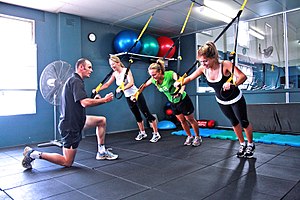Suspension training
The term suspension training refers to an approach to strength training that uses a system of ropes and webbing called a "suspension trainer" to allow users to work against their own body weight.

Description

The field of suspension training is a form of resistance training that includes bodyweight exercises in which a variety of multi-planar, compound exercise movements can be performed. These are done with the aim of developing strength, balance, flexibility, and joint stability simultaneously.[1] Suspension training develops physical strength while using functional movements and dynamic positions [2] The actual term "suspension training" is a trademark of FITNESS ANYWHERE, LLC [3]
History
Rope training has been around as early as the 1800s.[4]
Randy Hetrick, a former Navy Seal and Stanford MBA graduate, developed the Total Resistance eXercise (TRX) [5][6] equipment and the associated Suspension Training bodyweight exercises in the 1990s,[7] and started marketing it in 2005. Kurt Dasbach, a former professional soccer player in Chile, discovered an ancient Andean conditioning system that utilized ropes[non-primary source needed] while playing in South America and developed a rival product, Inkaflexx, around the same time.
In 2008, ex Bristol City F.C. fitness coaching team Mark Hammond and Pete Faulkner developed the FKPro two-strap system. In 2009 Fabio Martella MMA coaching wrote the first TRX technical manual in Italy.[8] Another alternative is the aeroSling ELITE made in Germany. This "Suspended Pulley Trainer" also contains a pulley system.[1] The Hook Isometrics/Suspension Trainer by Sierra Exercise Equipment enables the user to use it for either suspension training or isometrics training. In 2010 Zita Alves, a Personal Trainer and Fitness Entrepreneur developed the Ztrainer Suspension Fitness System. Evolution has continued with newer suspension bodyweight trainers offering wider cambered workouts, such as the CoreX Suspension Trainer, which is designed to place less stress on joints and tendons than traditional suspension bodyweight trainer.[9]
Benefits and criticism
Proponents of suspension training argue that it develops core body strength, as well as joint and muscular stability,[10] reducing the chance of injury.[11] Some sports scientists have expressed concern that weaker individuals may not have the core stability or joint integrity to use the system safely and effectively.[12]
References
- ^ a b Burns, Nick (2007-02-01). "Suspension Training: How Risky Is It?". The New York Times. Retrieved 2015-05-24.
- ^ TRX Suspension Training
- ^ Suspension Training
- ^ Illustrations from 1866 book "Athletic Sports for Boys"
- ^ [1]
- ^ [2]
- ^ Edwards, Dolby. "Randy Hetrick – Inventor Of The TRX". http://efm.net.au/.
{{cite web}}: External link in|website= - ^ FKpro Testimonials
- ^ http://www.corexripfit.com/faqs/
- ^ A new tool for losing weight - Core Performance. Retrieved on 2009-06-08
- ^ They get a lift from their workouts - Boston Globe. Retrieved on 2009-06-08
- ^ Peta Bee (5 June 2007). "Does it work? - Suspension Training". The Guardian.
